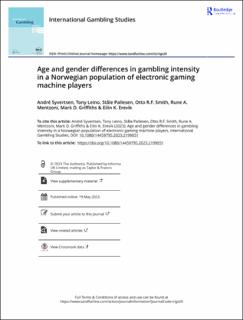Age and gender differences in gambling intensity in a Norwegian population of electronic gaming machine players
Syvertsen, Andre; Leino, Tony Mathias; Pallesen, Ståle; Smith, Otto Robert Frans; Mentzoni, Rune Aune; Griffiths, Mark D.; Erevik, Eilin K.
Journal article, Peer reviewed
Published version

Åpne
Permanent lenke
https://hdl.handle.net/11250/3070362Utgivelsesdato
2023Metadata
Vis full innførselSamlinger
Sammendrag
Participation in various types of gambling is associated with age and gender. Younger men tend to be drawn toward online gambling whereas women and older individuals tend to engage more in land-based gambling such as electronic gaming machines (EGMs). The present study examined how annual trends in theoretical loss, a robust measure of risk propensity/gambling intensity, varied according to age groups and gender among an EGM-population in Norway (N = 195,318, 26.5% women, age range 18 to 103 years [M = 40.13, SD = 16.29]). Quantile regression on the 25th percentile, median, and 90th percentile theoretical loss showed that higher theoretical loss at these quantiles were associated with older age. At the 90th percentile: Individuals aged 60–69 years had highest theoretical loss at 15,343 NOK (1,784 USD). Compared to men, women had higher 90th percentile theoretical loss (1,658 NOK≈193 USD). Interaction analyses showed that the positive association between age and theoretical loss was stronger for men compared to women. Gambling expenditure is positively associated with disordered gambling and the findings suggests that older individuals and women represent more vulnerable groups among the EGM population.
